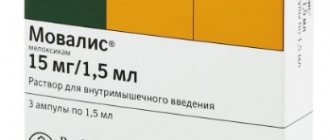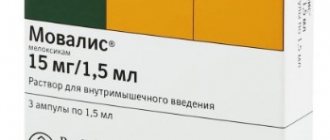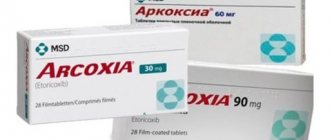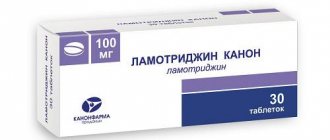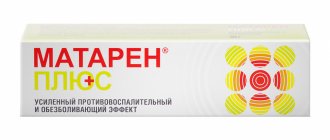Back pain is a common reason for patients to visit a doctor. There are many pathologies characterized by back pain: osteochondrosis, osteoarthritis, rheumatoid arthritis, spinal hernia. Movalis is one of the most effective drugs that can relieve pain.
Active ingredient
The active component of the drug, meloxicam, relieves any inflammation. This has been proven by clinical trials. Meloxicam inhibits the synthesis of prostaglandins (Pg), which are known to be mediators of inflammation. That is, Movalis acts precisely. As for cartilage tissue, it does not experience any negative effects during a course of taking the drug.
The pharmacological market boasts a variety of dosage forms of the drug: tablets, injection solution, rectal suppositories (suppositories), suspensions.
Movalis against arthritis of the fingers
It is worth noting that the injections are intended for the first 2-3 days of therapy, when the inflammatory and pain syndrome is most pronounced. After pain and inflammation are relieved, treatment continues using available dosage forms.
The analgesic effect can be observed after 30 minutes and lasts about a day after taking Movalis.
Indications
What do pills help with?
- symptomatic treatment of aggravated osteoarthritis;
- long-term treatment of infectious nonspecific polyarthritis and rheumatoid spondylitis.
What do injections help with?
- short-term treatment of an acute attack of infectious nonspecific polyarthritis or rheumatoid spondylitis, when the rectal and oral routes of administration of the drug Movalis are impossible.
Why is the suspension prescribed?
- symptomatic treatment of osteoarthritis (including with a pain component), rheumatoid arthritis (including juvenile arthritis), rheumatoid spondylitis
Interaction
NSAIDs (including salicylates and corticosteroids) in combination with Meloxicam , due to the synergy of their action, increase the risk of ulceration of the digestive canal and the development of gastric and intestinal bleeding.
of Meloxicam in combination with other NSAIDs, as well as Methotrexate and lithium preparations should be avoided .
Thrombolytic agents , systemic heparin oral anticoagulants , SSRIs, and antiplatelet agents in combination with meloxicam may cause bleeding; diuretics and AT1 receptor blockers - ARF.
NSAIDs, due to the suppression of Pg, which has vasodilating properties, reduce the effect of antihypertensive drugs . In addition, drugs in this group increase the nephrotoxicity of Cyclosporine .
Cholestyramine binds meloxicam in the digestive canal and thereby accelerates its elimination.
The presence of sorbitol in the suspension can cause the development of necrosis of the large intestine with possible death if Movalis is taken with sodium polystyrene sulfonate.
Pharmacokinetic interaction is not excluded in case of combined use with drugs that suppress CYP3A4 and/or CYP2C9, and oral hypoglycemic drugs. The drug may reduce the effectiveness of the IUD.
Use in combination with Digoxin , Cimetidine , antacids and Furosemide does not lead to significant changes in pharmacokinetic parameters.
Contraindications
The use of Movalis is prohibited in the following cases:
- active gastrointestinal bleeding, recent cerebrovascular bleeding or established diagnosis of diseases of the blood coagulation system;
- concomitant therapy with anticoagulants, because there is a risk of intramuscular hematoma formation;
- severe liver failure;
- severe heart failure;
- severe renal failure (if hemodialysis is not performed, CC <30 ml/min, and also with confirmed hyperkalemia);
- active liver disease;
- erosive and ulcerative lesions of the stomach and duodenum in the acute phase or recently suffered;
- inflammatory bowel diseases (Crohn's disease or ulcerative colitis in the acute phase);
- therapy of perioperative pain during coronary artery bypass grafting;
- pregnancy;
- lactation period (breastfeeding);
- age under 18 years;
- hypersensitivity to the active substance or auxiliary components of the drug.
- hypersensitivity (including to other NSAIDs), complete or incomplete combination of bronchial asthma, recurrent polyposis of the nose or paranasal sinuses, angioedema or urticaria caused by intolerance to acetylsalicylic acid or other NSAIDs (including a history) due to existing potential for cross-sensitivity.
Movalis should be used with caution in old age
Use with caution if you have:
- history of gastrointestinal diseases (presence of Helicobacter pylori infection);
- congestive heart failure;
- cerebrovascular diseases;
- dyslipidemia/hyperlipidemia;
- diabetes;
- peripheral arterial disease;
- renal failure (creatinine clearance 30-60 ml/min);
- IHD;
- elderly age;
- long-term use of NSAIDs;
- smoking;
- frequent drinking of alcohol;
- concomitant therapy with the following drugs: anticoagulants, oral corticosteroids, antiplatelet agents, selective serotonin reuptake inhibitors.
Contraindications for use in pediatrics:
- tablets - age up to 16 years;
- d/i solution - age up to 18 years;
- candles - age up to 12 years;
- suspension - age up to 12 years (for juvenile arthritis, the restriction for use is age up to 2 years).
Compound
The drug contains the active substance meloxicam , as well as the following auxiliary components:
Movalis tablets: sodium citrate, lactose monohydrate, MCC, povidone, anhydrous colloidal silicon dioxide, magnesium stearate, crospovidone.
Ingredients of the injections: meglumine, glycofurol, poloxamer 188, glycine, sodium hydroxide, sodium chloride, purified water.
Movalis suppositories: basis for the manufacture of suppositories suppositir BP, cremophor RH40 (polyethylene glycol glyceryl hydroxystearate).
Movalis suspension: colloidal silicon dioxide, hyaetellose, sorbitol , glycerol , xylitol; benzoate, saccharinate and sodium dihydrogen phosphate dihydrate; citric acid monohydrate, raspberry flavor, purified water.
Side effects
Side effects - headache
As with therapy with other NSAIDs, while taking Movalis, there is a possibility of adverse reactions from the body:
- From the urinary system: edema, hypercreatininemia, increased urea concentration. In rare cases - interstitial nephritis, glomerulonephritis, renal medullary necrosis, nephrotic syndrome.
- From the digestive system: nausea, vomiting, belching, abdominal pain, constipation or diarrhea, flatulence, increased activity of “liver” transaminases, hyperbilirubinemia, stomatitis, erosive and ulcerative lesions of the gastrointestinal tract, gastrointestinal bleeding (hidden or obvious), perforation of the digestive tract canal, colitis, dyspepsia, gastroduodenal ulcer, esophagitis, gastritis, hepatitis.
- From the cardiovascular system: increased blood pressure, “flushes” of blood to the skin of the face and upper chest, palpitations.
- From the nervous system: dizziness, headache, drowsiness, mood lability, confusion, disorientation..
- From the hematopoietic organs: anemia, leukopenia, thrombocytopenia.
- Allergic reactions: skin rash, itching, blisters, erythema multiforme, Lyell's syndrome, bullous dermatitis, Stevens-Johnson syndrome, angioedema, hypersensitivity to UV radiation, urticaria, anaphylactoid reactions.
- Other: ringing in the ears, blurred vision, conjunctivitis.
Combination use of the drug Movalis and drugs that suppress the functioning of the bone marrow can provoke cytopenia (deficiency of one or more types of blood cells). If gastrointestinal bleeding, perforation or ulcer occurs during treatment with Movalis, this can lead to death.
When using a d/i solution, the following are possible:
- glomerular or interstitial nephritis;
- papillary necrosis;
- nephrotic syndrome;
- swelling and pain at the injection site.
Overdose
Acute overdose of NSAIDs is usually accompanied by lethargy, nausea, drowsiness, abdominal pain, and vomiting. With adequate supportive treatment, these symptoms are reversible.
In some cases, bleeding from the gastrointestinal tract may develop. Severe poisoning can provoke arterial hypertension , acute renal failure, liver dysfunction, respiratory depression, convulsions , coma , heart failure and cardiac arrest .
Also, the possibility of the patient developing anaphylactoid reactions cannot be excluded.
In case of an overdose of NSAIDs, symptomatic treatment is indicated for the patient. Studies have shown that taking 4 oral doses of cholestyramine twice a day allows meloxicam in the digestive canal and speed up its elimination.
How to take Movalis
General advice for the use of any of the dosage forms of Movalis is that the drug is recommended to be used in the minimum effective dose, and the therapeutic course should last as short as possible. Moreover, during treatment, it is recommended to assess the need for taking the drug and the body’s response. During the day, you can take, regardless of the dosage form of the drug Movalis, only 15 mg/day. This is the maximum for the day.
How to take Movalis medicine correctly?
Movalis tablets and suspension are taken orally during meals with a sufficient amount of water.
- osteoarthritis: 7.5 mg/day. If indicated and the severity of the pain syndrome, it is possible to increase the dose to 15 mg/day;
- rheumatoid arthritis, ankylosing spondylitis: 15 mg/day. (possibly reducing the dose by 2 times);
- Children under 12 years of age are prescribed Movalis in the form of a suspension for the treatment of juvenile rheumatoid arthritis. The dose is calculated based on body weight - 0.125 mg/kg (maximum - 7.5 mg per day).
- children 12-18 years old with juvenile rheumatoid arthritis: 0.25 mg/kg, but not more than 15 mg per day.
It is recommended to use the following dosage regimen (amount of active substance/volume of suspension):
- 12 kg: 1.5 mg/1 ml;
- 24 kg: 3 mg/2 ml;
- 36 kg: 4.5 mg/3 ml;
- 48 kg: 6 mg/4 ml;
- From 60 kg: 7.5 mg/5 ml.
Release form
The drug is available in:
- tablet form (active substance dosage 7.5 mg (package No. 20) and 15 mg (package No. 10 or No. 20));
- solution for injection 10 mg/ml (ampoules 1.5 ml, package No. 5);
- rectal suppositories 7.5 and 15 mg (package No. 6);
- suspension 1.5 mg/ml (100 ml bottle).
The tablets have a flat-cylindrical shape and beveled edges. One side is marked with the company logo, the other has a fault line. The color of the tablets is from pastel yellow to lemon yellow; roughness on the surface is allowed.
The solution is yellow with a greenish tint, transparent.
The suppositories are smooth, yellowish-green, and have a funnel-shaped depression at the base.
The suspension is a viscous substance of yellowish-green color.
The manufacturer does not produce external therapy products (ointment, gel).
Injections with Movalis: instructions for use
Movalis in ampoules is used exclusively intramuscularly (intravenous use is prohibited). The medicine is administered once in a dose of 15 mg. Typically, injections with Movalis are used in the first 2-3 days of therapy.
The medicine is administered slowly, by deep injection into the gluteus maximus muscle.
The recommended daily dose is 7.5 mg or 15 mg 1 time/day, depending on the intensity of pain and the severity of the inflammatory process.
- Osteoarthritis with pain: 7.5 mg/day. If necessary, the dose can be increased to 15 mg/day;
- Rheumatoid arthritis: 15 mg/day. Depending on the therapeutic effect, the dose can be reduced to 7.5 mg/day;
- Ankylosing spondylitis: 15 mg/day. Depending on the therapeutic effect, the dose can be reduced to 7.5 mg/day.
Movalis suppositories: instructions for use
For adults with osteoarthritis, rheumatoid arthritis or spondylitis, rectal suppositories are administered at a dose of 7.5 mg 1 time / day. If indicated, the dose can be increased to the maximum possible per day - 15 mg.
Reviews about Movalis
Reading reviews on forums, you can see that the majority of patients who took Movalis give this drug a fairly high rating.
The medicine quickly accumulates in the body, is slowly eliminated, its bioavailability is higher than that of its analogues, and the variety of forms allows you to choose the most convenient one, depending on the indications and subjective sensations.
The drug has a relatively small range of undesirable side effects compared to other NSAIDs and proven high clinical effectiveness.
This allows it to be included in the complex therapy of many pathological conditions that accompany inflammatory and degenerative rheumatic diseases , as well as to be used to relieve pain in primary dysmenorrhea and fever .
Reviews of Movalis injections indicate that immediately entering the bloodstream after administration, the drug in this dosage form quickly relieves even severe excruciating pain.
Reviews of Movalis tablets are also mostly positive. The main advantage of this form of meloxicam is that it can be used for a long time (from 4 weeks to one and a half years) of time.
Special instructions for the use of the drug Movalis:
- for patients with an increased risk of adverse reactions (history of gastrointestinal diseases, presence of risk factors for cardiovascular diseases), the recommended initial daily dose is 7.5 mg;
- For patients with severe renal failure on hemodialysis and the elderly, a dose of 7.5 mg/day is recommended, which should not be exceeded;
- patients with insufficient renal function in which Clcr exceeds 25 ml/min., patients with mild/moderate liver failure, as well as clinically stable cirrhosis do not require dose adjustment.
Important! The required dosage and course duration are determined by the attending physician.
Movalis during pregnancy and breastfeeding
As with other Pg (prostaglandin) inhibitors, meloxicam may have a negative effect on fertility. Therefore, when planning pregnancy, it is recommended to discontinue therapy with this drug.
Movalis during pregnancy
Suppression of prostaglandin synthesis has a negative impact on the development of pregnancy and/or the fetus. In particular, clinical data suggest that Movalis in the first and second trimesters of pregnancy increases the risk of miscarriages, as well as the chance of gastroschisis and heart defects in the fetus. Therefore, during this period, Movalis is prescribed by a doctor only if there is a real threat to the mother’s life.
As for the third trimester, taking the drug at this time can lead to abnormalities in fetal development:
- cardiorespiratory toxicity;
- renal dysfunction, which can develop into renal failure with oligohydramnios.
In addition, taking Movalis in the last weeks of pregnancy can provoke an increase in bleeding time, the development of an antiaggregation effect, inhibition of the ability of the smooth muscles of the uterus to contract, and this leads to a delay or disruption of the birth process.
The active component of Movalis easily passes into mother's breast milk, so it should not be taken during breastfeeding (breastfeeding).
Pharmacodynamics and pharmacokinetics
Pharmacodynamics: what is Meloxicam and how does it work?
Wikipedia states that the mechanism of action of the drug is based on its ability to suppress the production of Pg. Its pronounced anti-inflammatory activity has been established in all standard models of inflammation.
In vivo, it suppresses the synthesis of Pg in the pathological focus to a greater extent than in the kidneys or in the gastric mucosa, which is associated with a more selective inhibition of the COX-1 isoenzyme compared to COX-2.
It is generally accepted that the therapeutic effectiveness of NSAIDs is due to the inhibition of COX-2, while the renal and gastrointestinal side effects of these drugs arise from the suppression of the constitutively present isoenzyme COX-1.
Selectivity for COX-2 has been confirmed in various tests, both in vitro and ex vivo. In ex vivo models, liposaccharide-stimulated production of PgE2, which is controlled by COX-2, was more actively suppressed than the production of thromboxane, which is involved in the hemocoagulation process, which is controlled by COX-1. The effects were dose-dependent.
It has also been shown in ex vivo models that, at recommended doses, the drug does not alter bleeding time or affect platelet . This fundamentally distinguishes Meloxicam from Ibuprofen , Indomethacin , Diclofenac and Naproxen .
Clinical studies have established that NSAID gastropathy develops significantly less frequently when taking Meloxicam than when taking other NSAIDs. Vomiting, abdominal pain, nausea, and dyspepsia were reported less frequently in patients taking Meloxicam than in patients taking other NSAIDs.
meloxicam- related upper gastrointestinal bleeding, perforation , and was low and dose-related.
Pharmacokinetics:
- absorption from the digestive canal is good, does not change with simultaneous food intake;
- bioavailability - 89% (when taken orally);
- TSmax for a single dose is 5-6 hours, during the period of steady state pharmacokinetic parameters (when taking Meloxicam in tablets and suspension form) - 5-6 hours;
- the time to achieve a steady state of pharmacokinetic parameters with repeated use is 3-5 days;
- binding to albumin (plasma proteins) - 99%; T1/2 (average) - 20 hours.
Dosing 1 r./day. leads to an average plasma concentration with slight fluctuations in peak values: for 7.5 mg within 0.4-1, for 15 mg - within 0.8-2 μg/ml (Cmax and Cmin during the period of steady state pharmacokinetic parameters).
Honey concentrations of the drug after systematic use for more than six months are similar to the concentrations observed after 14 days. oral dose 15 mg.
The pharmacokinetics indicators (Cmax, Cmin, TCmax) of Meloxicam in the form of suppositories are similar to those for tablets.
The drug penetrates well into the synovium.
Metabolism occurs in the liver. The resulting substances are pharmacologically inactive. Meloxicam is excreted equally in urine and feces, in pure form - up to 5% of the dose. Only trace concentrations of the pure substance are found in urine.
Movalis and alcohol
Is it possible to combine Movalis with alcohol?
There is no clear prohibition on the simultaneous use of Movalis and alcohol in the instructions for use. True, this does not mean that such a combination will not cause harm. Thus, drinking alcohol during therapeutic treatment with the drug can lead to acute renal failure. This occurs due to dehydration, which is caused by alcohol.
Is it possible to take Milgamma, Movalis and Mydocalm at the same time?
If the pain is severe, causes discomfort, cannot be tolerated, and affects the usual rhythm of life, then the doctor may prescribe a combined treatment system. Milgamma and Mydocalm are often prescribed along with Movalis, which have shown good results in the treatment of certain diseases (intervertebral hernia, osteochondrosis). But before injecting Movalis, Milgamma and Mydocalm, you need to visit a doctor, since these drugs in any case have contraindications and the risk of developing negative reactions in the patient’s body.
- Movalis is a non-steroidal anti-inflammatory drug. Its use is indicated in the treatment of diseases of the musculoskeletal system to relieve inflammation, pain and lower temperature.
- Milgamma is a combined multivitamin product consisting of B vitamins. When diagnosing diseases of the musculoskeletal system, Milgamma injections are prescribed to improve blood circulation, nourish cartilage and bone tissue, and strengthen the nervous system.
- Mydocalm is a muscle relaxant. The drug relieves muscle spasms, reduces muscle tension, reduces compression of nerve endings and eliminates pain.
The classic treatment regimen with Movalis, Milgamma and Mydocalm looks like this: during the first three days, Movalis injections are administered once a day, then the patient is transferred to the tablet form of the drug. Milgamma is administered 2 ml IM once a day. Then injections are given two to three times a week, or the tablet form of Milgamma is prescribed.
Mydocalm injections (100 mg) are indicated 2 times a day, the dosage is 100 mg. To enhance the effect, injections can be given on the same day.
Thus, Movalis, Milgamma and Mydocalm are prescribed to eliminate the symptoms of the disease. Despite the fact that the drugs belong to different pharmacological groups, when used together they give positive dynamics during therapy.
It is worth remembering that for patients who are sensitive or intolerant to lidocaine, this treatment regimen is contraindicated.
Analogs
Analogues of Movalis on the pharmaceutical market are the following drugs: Mirlox, Artrosan, Melox, Meloxicam, Mataren.
As for Movalis injections, the doctor can replace them with medications containing the same active ingredient: Amelotex, Arthrozan, Meloxicam, Melbek, Liberum, Bi-xicam, Movasin, Mesipol.
Analogues of the drug Movalis
Movalis/Meloxicam
The drugs are based on the same active substance, so their therapeutic effect is identical. The only difference is the price.
Movalis/Voltaren
The active substance of Voltaren is diclofenac. Frequent development of side effects is noted. Unlike Voltaren, Movalis has a positive effect on cartilage metabolism. Therefore, both drugs are effective for pain relief, but for osteoarthritis, Movalis is better.
Movalis/Nise
The active substance of Nise is nimesulide. Both drugs are characterized by effectiveness in treating heat, inflammation and pain.
But nimesulide is toxic to the liver, but Movalis is not and does not have a similar effect.
Movalis relieves pain more slowly, but its effect is prolonged, while Nise is good for quickly relieving pain.


